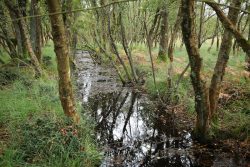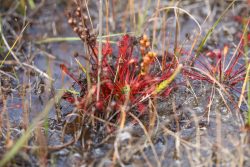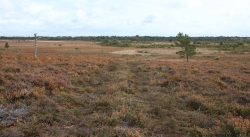 WORK is under way to restore and re-wet peatland at Holt Mire near Wimborne, to protect a rare floating spider and flesh-eating sundew plants. Holt Mire is an important peatland habitat on Holt Heath National Nature Reserve, one of the largest areas of lowland heath in Dorset, cared for by the National Trust.
WORK is under way to restore and re-wet peatland at Holt Mire near Wimborne, to protect a rare floating spider and flesh-eating sundew plants. Holt Mire is an important peatland habitat on Holt Heath National Nature Reserve, one of the largest areas of lowland heath in Dorset, cared for by the National Trust.
The restoration is part of the Dorset Peat Partnership’s £1 million project to reinstate peatlands on 16 sites across the county. An area of 98 hectares of peatland – 242 acres – equivalent to more than 180 football pitches, is being restored on Holt Heath. Drainage ditches are being blocked to raise the water table and vegetation cleared to encourage peatland flora and fauna to recover and thrive – including the floating Raft Spider and the carnivorous Sundew plant.
 The project will tackle climate change and benefit nature, while also improving drought and fire resilience by holding more water in the landscape during the summer and soaking up heavy rainfall. In December 2023, fire crews from Dorset & Wiltshire Fire and Rescue tackled a large wildfire at Holt Heath, which destroyed 3.7 hectares (nine acres).
The project will tackle climate change and benefit nature, while also improving drought and fire resilience by holding more water in the landscape during the summer and soaking up heavy rainfall. In December 2023, fire crews from Dorset & Wiltshire Fire and Rescue tackled a large wildfire at Holt Heath, which destroyed 3.7 hectares (nine acres).
Peatlands play a critical part in tackling climate change. They capture and store up to three times as much carbon as woodlands, but they are in decline – 80% of peatland in the UK has been affected by human activity including development, drainage for agriculture, and forestry and the removal of peat and the drying out of these special landscapes is having a major impact on nature.
 Dorset’s peatlands are a mosaic of rich and diverse wetland habitats, bogs, mires and fen spread across our lowland heath habitats. They are internationally recognised for their ecological significance and are home to migratory birds, rare damselflies, amphibians and reptiles, which rely on the condition of these wet mire heath habitats to survive.
Dorset’s peatlands are a mosaic of rich and diverse wetland habitats, bogs, mires and fen spread across our lowland heath habitats. They are internationally recognised for their ecological significance and are home to migratory birds, rare damselflies, amphibians and reptiles, which rely on the condition of these wet mire heath habitats to survive.
Eleanor Egan, the National Trust’s countryside manager for Kingston Lacy, says: “Holt Mire is an incredibly important and unusual habitat in Dorset. Restoring the peatland will stop carbon from being released from the degrading peat and eventually encourage the creation of more peat. This project will also safeguard a rare and beautiful habitat that is home to many weird and wonderful creatures that just aren’t found anywhere else.”
 Grace Hervé, the Dorset Peat Partnership Project manager, says: “This partnership is demonstrating real success on how to work with nature and tackle multiple problems in one go. The simplicity of the restoration works, using just the natural materials already present on site, to form peat blocks in drainage channels to hold back water, is truly incredible – the results are immediate.”
Grace Hervé, the Dorset Peat Partnership Project manager, says: “This partnership is demonstrating real success on how to work with nature and tackle multiple problems in one go. The simplicity of the restoration works, using just the natural materials already present on site, to form peat blocks in drainage channels to hold back water, is truly incredible – the results are immediate.”
Led by Dorset Wildlife Trust, the key partners of the Dorset Peat Partnership are Natural England, the Environment Agency, Forestry England, BCP Council, the National Trust, Dorset Catchment Partnership, the RSPB and one private landowner. Funding of £787,000 came from Defra’s Nature for Climate Peatland Grant Scheme. A further £262,000 came from additional funding sourced from project partners.
Pictures of Holt Mire, a slow worm, carnivorous sundew and a drainage ditch waiting to be filled, by Alex Dixon Photography © National Trust